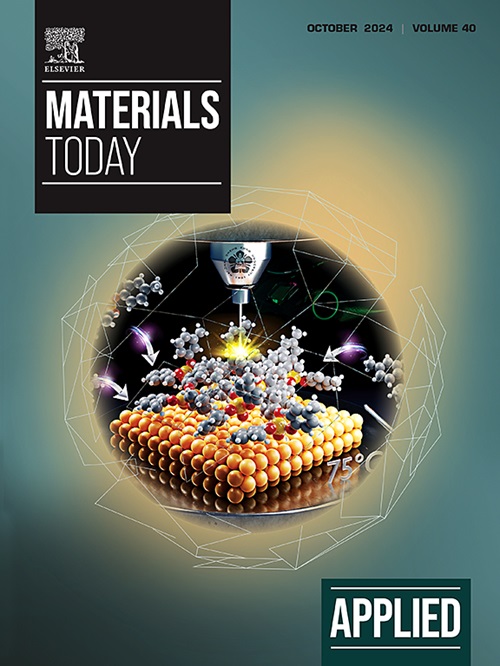Tough and self-healing linear polydimethylsiloxane elastomer with multiple hydrogen bonds for high-performance piezoresistive pressure sensor
IF 6.9
2区 材料科学
Q1 MATERIALS SCIENCE, MULTIDISCIPLINARY
引用次数: 0
Abstract
With the rapid development of flexible electronics, the functional elastomer with excellent mechanical properties as substrate for the preparation of high-performance piezoresistive pressure sensor has become one of the frontier research hotspots. Here, a tough and self-healing linear polydimethylsiloxane (PDMS) elastomer with multiple hydrogen-bonding interactions was synthesized, and then utilized as substrate to prepare piezoresistive pressure sensor with 2-ureido-4[1H]-pyrimidinone modified carbon nanotubes (UPy-CNTs) as conductive material and salt particles as sacrificial template to construct electrical pathways and ridge-like microstructure, respectively. The obtained elastomer showed high transmittance of above 90 % and excellent mechanical properties with tensile strength of 4.23 MPa, elongation at break of 984 % and toughness of 24.83 MJ m. With the exchange and reconstruction of multiple hydrogen bonds, the elastomer achieved high healing efficiency of 99.1 % after healing at 80 °C for 24 h. In addition, the elastomer-based piezoresistive pressure sensor exhibited high sensitivity of 2.04 kPa, wide sensing range of 0–450 kPa, short response/recovery time of 80/100 ms and excellent sensing repeatability (8000 loading-unloading cycles). The sensor was successfully applied for detecting various human motions, including finger and knee bending, exhalation, swallowing and heart-pulse, and realized remote transmission of pressure signals with a wireless monitoring circuit. Furthermore, the sensor could restore its sensing function even after being cut into two halves, showing great potential in the fields of wearable device, health monitoring and electronic skin.用于高性能压阻式压力传感器的具有多个氢键的坚韧自愈合线性聚二甲基硅氧烷弹性体
随着柔性电子技术的快速发展,以具有优异力学性能的功能弹性体为基底制备高性能压阻压力传感器已成为前沿研究热点之一。本文合成了一种具有多种氢键相互作用的韧性和自愈合性的线性聚二甲基硅氧烷(PDMS)弹性体,并以2-脲基-4[1H]-嘧啶酮修饰的碳纳米管(UPy-CNTs)为导电材料,以盐颗粒为牺牲模板,分别构建了电通路和脊状微结构,以此为基底制备了压阻压力传感器。获得的弹性体具有 90% 以上的高透光率和优异的机械性能,拉伸强度为 4.23 兆帕,断裂伸长率为 984%,韧性为 24.83 兆焦耳。此外,基于弹性体的压阻压力传感器具有 2.04 kPa 的高灵敏度、0-450 kPa 的宽传感范围、80/100 ms 的短响应/恢复时间和出色的传感重复性(8000 次加载-卸载循环)。该传感器被成功应用于检测各种人体运动,包括手指和膝盖弯曲、呼气、吞咽和心搏,并通过无线监测电路实现了压力信号的远程传输。此外,该传感器在被切割成两半后仍能恢复传感功能,在可穿戴设备、健康监测和电子皮肤领域显示出巨大潜力。
本文章由计算机程序翻译,如有差异,请以英文原文为准。
求助全文
约1分钟内获得全文
求助全文
来源期刊

Applied Materials Today
Materials Science-General Materials Science
CiteScore
14.90
自引率
3.60%
发文量
393
审稿时长
26 days
期刊介绍:
Journal Name: Applied Materials Today
Focus:
Multi-disciplinary, rapid-publication journal
Focused on cutting-edge applications of novel materials
Overview:
New materials discoveries have led to exciting fundamental breakthroughs.
Materials research is now moving towards the translation of these scientific properties and principles.
文献相关原料
公司名称
产品信息
阿拉丁
Oil red O
阿拉丁
Adipic acid dihydrazide
阿拉丁
Isophorone diisocyanate
 求助内容:
求助内容: 应助结果提醒方式:
应助结果提醒方式:


